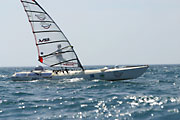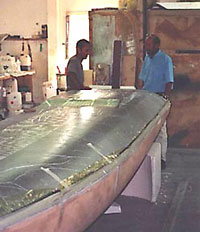| 

Architect :
Guy Saillard (Ploemeur)
L.O.A. :
7,80 m
L.W.L. :
6,80 m
Beam :
1,30 m
Hull depth :
0,75 m
Draught :
1,05 m
Loaded weight :
approx. 500-550 kg
Materiau :
sandwich carbon-airex-epoxy, internal
walls in NIDA
Batteries :
12V / 120 AH
Solar panels :
12V / 120 W
Desalinisator :
Power survivor 12V / 5 liters/h
Telephone :
Iridium (official suppliers : E.T.N.A.
et TDCom)
Positioning :
GPS Furuno GP 50 Mark 2
Radio :
VHF Icom IC GM 1500 |
 |
| Réf. GMR
3520 - Photo Gilles Martin-Raget |
 |
| Réf. GMR
3381 - Photo Gilles Martin-Raget |
|
Rigging :
official supplier Neil Pryde, 6 latted sails
in monofilm (RAFJET serie modified), of 4 surfaces
4.2 to 7.4 m2; 4 masts in carbon and 3 wishbones
in aluminium
Food :
dehydrated food (Knorr Bivouac), freeze
dried food (Voyager), dry fruit, cookies, energy
bars, jerky imported from Canada (Mirab, USA)
Construction :
J.P.K. Composites (Larmor-Plage) in 2001,
Sailing Concept (La Ciotat) in 2002-2003.
|


The new sailboard is lighter and faster
than the one which was used during Raphaela’s
Atlantic crossing. It was built in 2001 by JPK Composites
(Larmor Plage, France) according to drawings made by
Guy Saillard (naval architect and expert).
 |
| Réf. P0013 - Photo R.
le Gouvello |

 |
| Photo H. André |
Who else better than Guy Saillard
can talk about his SAILBOARD ?
Guy, what are the main constraints
to design and build such an «Open Sea» sailboard ?
The main constraint is to be fully
autonomous, e.g. to be able to live on such sailboard
independently, not requiring any assistance from another
boat which would provide a wrong safety feeling.
Raphaela’s board should be floating in any circumstances
even if it is damaged (despite the construction in sandwich
carbon/kevlar/epoxy). It should be of course strong
and light at the same time.
How long did the construction
last ?
The construction of the board
was done between July and September 2001. All the equipment
was then gradually installed. And it took us almost
a year to achieve this phase. Every work that has to
be done on the board requires a lot of attention and
precision, is uneasy because of the tiny available space.
It is therefore very much time consuming.
We worked on and in the board again in 2003, mainly
to set up the airbag system in collaboration with the
ESA.
You designed and had built
the sailboard that Stéphane Peyron used for his
Atlantic crossing in 1987, the same board that Raphaëla
used for her own Atlantic crossing 13 years later…
what are the main changes brought to this new board ?
The main point was to further
investigate lightness, for instance the internal walls
in NIDA. The board front is finer to better pass the
waves. The back is flatter to better surf them.
The command rudder system is also much more sophisticated
: the tiller sectors are made very adjusted in carbon,
they weigh 350 g and allow the use of kevlar ropes.
This was all done to avoid the troubles that Raphaela
encountered during her Atlantic crossing with the old
and heavy equipment.
And in addition, the airbag system developed with the
ESA is a true technological innovation.
Can you talk about this airbag
system ?
After Raphaela’s first attempt
to cross the Mediterranean sea which ended up in a capsize
and difficulties to upright the sailboard by Raphaela
alone, the crossing of the Mediterranean sea went well
in the second attempt. And we decided to double all
the safety procedures.
This is particularly crucial for the Pacific crossing
as Raphaela will follow a route very far from any regular
vessel route. She is for sure able to upright her sailboard
alone but we must anticipate any kind of worst case.
With the ESA, we have therefore developed a unique and
prototype airbag system.
An airbag which volume has been calculated according
to the sailboard specificities is fixed onto Raphaela’s
sailboard, at the back of the board. In case of a capsize,
the airbag will be able to inflate very rapidly, released
by an emergency manual signal placed in the cabin of
the sailboard or externally. When inflated, the airbag
will create a disbalance of the capsized sailboard and
consequently, the board will turn back to its normal
right position. The airbag is inflated by an air-gas
system including pyrotechnical cartouches specifically
designed by the SEVA Technologies engineers who closely
work with ESA. The commands of such emergency system
will be electrical.
Such a collaboration with ESA has allowed us to access
high technologies related to airbag inflation.


|

